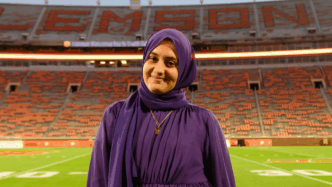This school year, the Clemson University School of Nursing is celebrating its 50th anniversary with an alumni gathering on Saturday. In 50 years, the program has grown from a traditional baccalaureate program and an associate degree to several undergraduate and graduate degrees.
We had the chance to talk with School of Nursing Director Kathleen Valentine about how nursing education has changed in the past 50 years, how the School of Nursing has adapted to those changes and the future of nursing education.

What are some of the ways nursing education has changed in 50 years?
In the last 50 years, nursing education has shifted to focus not only on nursing skills such as inserting an IV, but the depth and breadth of scientific, theoretical and clinical knowledge required to diagnose and treat human response to actual or potential health problems and increased well-being. Nursing education now also has a stronger focus on interprofessional clinical learning and complex simulation scenarios. Similarly, to K-12 education, nursing education has shifted from the traditional lecture style of classroom to a more interactive classroom with integrated technology. The objective is to teach students how to learn, think critically and apply clinical reasoning rather than memorize information.
Within the simulation lab, students once worked with mannequins, resembling those seen in a department store, and now they work with high-fidelity patient simulators that can be made to talk, breath and even bleed. Students are learning holistic care, viewing everything about a patient as connected and meaningful, by attending to what matters most to the patient, which is providing knowledgeable and personalized care.

How has the Clemson School of Nursing education incorporated technology into the classroom?
We have introduced virtual classrooms in the RN to BS, the Healthcare Genetics Ph.D., and Doctor in Nursing Practice programs, which are all online.
Technology has not only influenced how professors are teaching, but what they are teaching. In 2016, Professor Nancy Meehan began integrating 3-D printing into her nursing informatics course as a way to teach critical thinking. Undergraduate nursing students are becoming certified in 3-D printing. Since starting projects where students have to come up with a solution to a health care challenge, more than 100 nursing innovation projects have been created, such as specialized cups for stroke patients or a wrist brace.
How has some of the coursework changed in the School of Nursing?
We determined that with new scientific knowledge and discoveries, it was essential that we integrate human genetics throughout our undergraduate, and graduate programs. That knowledge is now a core dimension of the nursing profession as we care for patients and families.
Nurses must assess and anticipate individualized patient needs and create the environment for that person to heal and increase well-being even if experiencing a life-limiting condition. When I was in school, I remember my learning experiences were more compartmentalized. For example, we went to separate stations to learn skills, communication or assessment. We had less emphasis on the integration of all essential care elements necessary for personalized treatment. Though we had community health nursing experiences, we focused less on the health and social determinants of a whole community. And now students are taught how social ecology shapes health outcomes for the public.
How has the Clemson School of Nursing physically grown over the past 50 years?

In recent years, the school has more than doubled freshman enrollment in the traditional baccalaureate program to help alleviate the nursing shortage. The collaboration with Prisma Health–Upstate, formerly known as Greenville Health System, was expanded and a second site of instruction was built on the Prisma Health Greenville Memorial Medical Campus in 2018. The Clemson University Nursing building is adjoined to the UofSC School of Medicine by a two-story connector, which allows for interprofessional education in the simulation centers.
How has the School of Nursing academically grown?
The graduate program offerings have grown to include the Master of Science degree for four tracks: the family nurse practitioner concentration, adult/gerontological nurse practitioner, nursing administration and nursing education. Other programs we offer now are a doctorate in nursing practice, and the Human Genetics Ph.D. degree, which is an interdisciplinary program. Since 2015, the school has offered a Global Health Certificate in which students focus on global health issues and outreach in low-resource countries.
We have also focused on reinvigorating efforts in research at the student and faculty levels. There are 12 faculty members who are Faculty Scholars within the Clemson University School of Health Research, a multidisciplinary unit of Clemson that facilitates medical research and scholarship. Students also have more Creative Inquiry opportunities in which undergraduate students work with faculty on research projects that may extend over several years where they start with a research project design all the way through dissemination.
What does the next 50 years look like for the School of Nursing and nursing education?

In the next 50 years, I believe it will be imperative to integrate human caring science with clinical and technological science for clinical practice in health systems. Additionally, informatics will be an integral part of nursing with the use of technology-enhanced interventions that occur outside the walls of a hospital. Care will be delivered where people live, work and play. The nurse will use remote access technology personalized to each person seeking health care. Nursing informatics, application of neuroscience principles for learning and adopting healthy habits, will be commonplace tools for nursing care. Nurses will care for individuals and also populations of persons sharing common conditions. This aggregate care extends to global communities. Though separated by location and distance we are all global citizens connected through shared human conditions, and disease. Health knows no borders.
With these new practice models emerging, nurse educators will be joining with colleagues in psychology, neuroscience, computer science applications, engineering, sociology, communication, and other health disciplines to better form interdisciplinary and interprofessional academic, clinical learning environments. Asynchronous and virtual reality learning, and technology created beyond our current imagination will shape nursing education. Education will be delivered to the student and I see robust, connected virtual learning communities becoming the norm, enabling students in remote areas access to best of class education.








